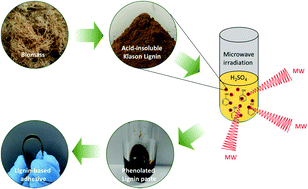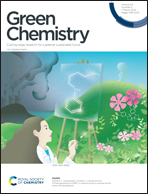Microwave-assisted phenolation of acid-insoluble Klason lignin and its application in adhesion†
Abstract
In this study, microwave irradiation is employed for the phenolation of acid-insoluble Klason lignin. Microwave irradiation significantly reduces the reaction temperature (180 → 100 °C) and time (6 h → 10 min) without noticeable differences in the chemical structure of the phenolated lignin compared with the products prepared using a conventional heating method. As the reaction temperature increases (100 → 150 °C), lignin decomposition and crosslinking occur simultaneously, as did phenolation. Upon increasing the phenol-to-lignin ratio, the fragmentation of lignin is enhanced, while the crosslinking reaction is inhibited, leading to a decrease in the molecular weight and glass transition temperature of the phenolated lignin. Density functional theory is applied to elucidate the thermal and non-thermal effects of the electromagnetic field on the phenolation of Klason lignin. The solubility of Klason lignin in tetrahydrofuran and methanol is highly enhanced after phenolation, which allows for its adhesive application on glass, polyethylene naphthalate, and polyimide substrates.



 Please wait while we load your content...
Please wait while we load your content...